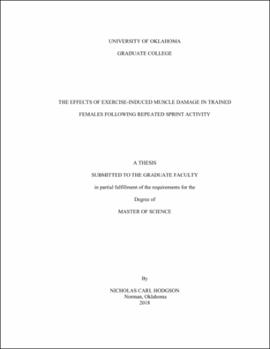| dc.description.abstract | Purpose: The purpose of the study was to evaluate the use of a sprinting protocol to consistently generate exercise-induced muscle damage (EIMD) using an active female population, and to observe how jumping metrics and sprint performance change due to muscle damage. The study also looked to examine the relationship between sprint velocity and player load, and how they relate to repeated sprint ability and lactate clearance. By using a field-based EIMD protocol in an active female population, the relationship between sprinting, jumping, and physiological markers of fatigue were examined. Methods: 10 trained females who routinely participate in sprint-based activity performed a repeated sprint protocol consisting of five sets of 8 maximal sprints, 20-meters in length, with a 5-meter deceleration zone. Immediately following the completion of each set of sprints, the participants performed a series of three countermovement jumps on a dual force plate, followed by a 2-minute period of rest prior to the start of the next set of sprints. Blood lactate and RPE were assessed immediately following the completion of the fifth set, with a repeated lactate test performed 3-minutes post and RPE 30-minutes post. Following 24-48 hours of rest, participants returned and provided soreness ratings, performed a set of three 20-meter maximal sprints with a 5-meter deceleration zone, and 3 countermovement jumps on a force plate to determine if the performance declines during the repeated sprint protocol are due to fatigue, muscle damage, or a combination of the two. Results: The repeated sprint protocol resulted in decreased sprint times and CMJ force metrics that persisted for up to 24-48 hours. The protocol also induced a high physiological load, as evidenced by elevated lactate values post-exercise and significant soreness in follow-up visits. Conclusion: Through this investigation, it was concluded that the protocol was a valid and reliable means of eliciting EIMD, with decrements in both sprinting and jumping performance persisting for up to 24-48 hours following the completion of the protocol. | en_US |
